Book contents
- Frontmatter
- Contents
- List of Figures
- List of Tables
- Acknowledgements
- List of Author and Contributors
- Introduction
- 1 Principles of Multicriteria Analysis
- 2 A Review of MCA Applications for Nature Conservation
- 3 Landfill Site Selection: Combining Spatial MCA with Stakeholder Analysis
- 4 Protected Area Zoning: Integrating Spatial MCA and Multi-objective Evaluation
- 5 Forest Landscape Restoration: Applying MCA to Design and Compare Options
- 6 Impact Assessment of Ski Areas: Combining GIS Indicators with MCA
- Conclusions
- Annex
- References
- Index
5 - Forest Landscape Restoration: Applying MCA to Design and Compare Options
Published online by Cambridge University Press: 16 July 2019
- Frontmatter
- Contents
- List of Figures
- List of Tables
- Acknowledgements
- List of Author and Contributors
- Introduction
- 1 Principles of Multicriteria Analysis
- 2 A Review of MCA Applications for Nature Conservation
- 3 Landfill Site Selection: Combining Spatial MCA with Stakeholder Analysis
- 4 Protected Area Zoning: Integrating Spatial MCA and Multi-objective Evaluation
- 5 Forest Landscape Restoration: Applying MCA to Design and Compare Options
- 6 Impact Assessment of Ski Areas: Combining GIS Indicators with MCA
- Conclusions
- Annex
- References
- Index
Summary
Context
Environmental decision-making problem
Forest resources are experiencing an alarming process of deterioration all over the planet, posing a threat to the protection of global biodiversity. Along with the protection of intact forests, reforestation and restoration interventions have been the main response to the problem of forest degradation and loss. Such interventions, carried out through a number of different techniques, aim at conserving biodiversity and improving both ecosystem functioning and human livelihoods (Lamb et al. 2005). In 2000, IUCN and WWF proposed the Forest Landscape Restoration (FLR) approach as an innovative approach to restore ecological integrity while enhancing human well-being. FLR shifts the attention from the single site to the landscape, as already proposed by Naveh (1994), because redesigning the landscape mosaic can offer opportunities for conserving biodiversity, improving ecological functioning and eventually benefit people. FLR is characterized by few key features: landscape-level view, ecological and socioeconomic perspective, stakeholder involvement and optimization of forest functionality (ITTO 2005).
One of the fundamental issue and a key stage in the FLR approach is the identification of areas that should receive priority for intervention (Vallauri et al. 2005). The prioritization issue is a common topic of conservation science when the shortage of resources calls for the identification of those sites whose protection is likely to provide the maximum benefits (Myers et al. 2000). The selection of an area as a reforestation priority depends on the objectives of the reforestation action. Typically, at a landscape scale, multiple and sometimes conflicting objectives have to be considered and traded-off in order to preserve landscape functionalities. Hence, the identification of reforestation priorities is a multi-objective planning problem in which nature conservation and other issues (social, economic) are involved (Kangas and Leskinen 2005). The multi-objective nature of the problem requires the use of different types of variables, often with different levels of (spatial) accuracy. For example, information related to forest cover can be derived from high-resolution satellite imagery, while poverty indices are typically assessed through surveys at municipal or district scale. Thus, suitable approaches are needed that allow handling and integrating such different information (Huby et al. 2007).
- Type
- Chapter
- Information
- Multicriteria Analysis for Environmental Decision-Making , pp. 63 - 78Publisher: Anthem PressPrint publication year: 2019



